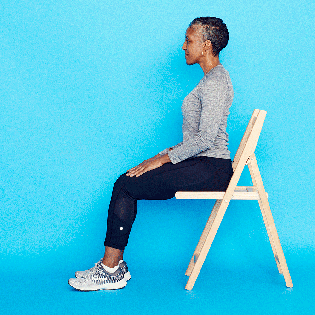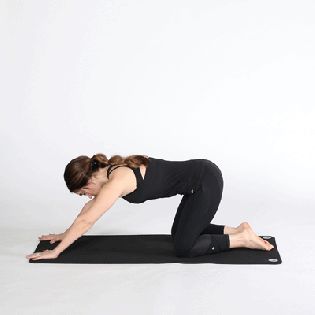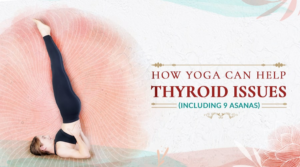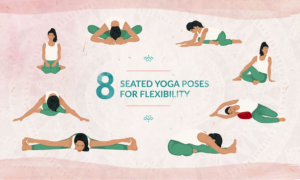Certain stretches can help relieve mid-back pain and stiffness and increase flexibility, such as seated twists and various yoga poses such as Child’s Pose, Cat-Cow Pose, and Threading the Needle.
Many lifestyle factors, medical conditions, and injuries can cause mid-back pain.
Symptoms of mid-back pain include:
- Short, sharp pain
- Dull, constant pain
- Muscle stiffness or tension
- Limited range of motion
These eight easy stretches, easy to do at home or in the office, can help relieve mid-back pain, release tight muscles, and improve mobility.
Before starting any exercises to relieve mid-back pain, it’s best to consult your doctor for advice, as some exercises are not suitable for everyone.
Sitting with hunched shoulders for long periods of time can tense up your mid-back muscles and limit your ability to rotate your spine . You need to focus on sitting upright , keeping your back straight and your head in a neutral position .
Seated twists help stretch your back muscles and gradually increase your range of motion in both directions.

To perform a seated twist:
- Sit upright and either cross your legs or stretch your legs out in front of you while bringing your shoulder blades together and down.
- Place your right hand on the outside of your left knee and your left hand behind your back for support. Slowly bend to the left.
- Hold for 20 to 30 seconds, then return to the center position.
- Repeat on the other side.
Child’s Pose is a simple yoga pose that allows the spine to passively extend while a person is lying on their knees.

To do Child’s Pose:
- Start in a kneeling position.
- Place your knees as wide apart as you feel comfortable, then bend forward, bringing your chest in toward your knees.
- If possible, place your forehead on the floor with your arms extended in front of you. Keeping your arms straight, place your hands lightly on the floor.
- Rest here for 5 to 10 breaths .
- Use your hands to slowly return your body to an upright position.
Threading the needle is a yoga pose that stretches the sides of your body, including your latissimus dorsi . This stretch also helps to loosen the muscles in your upper back.
For maximum benefit, keep your arms extended out to the side and focus on maintaining a comfortable, pain-free stretch.
To thread a needle:

- Start on all fours, with your knees directly under your hips and your feet in line with your knees.
- Keeping your hips, knees and feet stationary, move your hands forward under your shoulders.
- Rotate your chest as you reach your right arm under your left. Place your right hand on the floor with your palm facing up.
- Place the right side of your head lightly on the floor and lower your right shoulder as far as you can. Look up at the ceiling through your armpit.
- Hold this position for 20 to 30 seconds.
- Press up, using your right arm to slowly return to starting position, then repeat on the other side.
Like Child’s Pose, Cat-Cow Pose is a gentle yoga exercise that helps stretch and relax the muscles along your shoulders and spine.
To do Cat-Cow Pose:

- Start on all fours with your knees under your hips and wrists under your shoulders. Your spine should be in a neutral position.
- Inhale, lower your belly to the ground and push your hips out. Lift your head and shoulders and push your chest out to face forward. This is Cow Pose.
- As you exhale, arch your back like a cat. Tilt your pelvis toward your rib cage and widen your shoulder blades, lifting your abdomen off the ground. Keep your head on the floor.
- Alternate between these items every 30 to 60 seconds .
Downward Facing Dog is a yoga pose that strengthens your core and back muscles.

To do Downward Dog Pose :
- Start in a push-up position with your arms shoulder-width apart and your shoulders higher than your wrists.
- Bring your knee up and press through your front foot, straightening your leg and lifting your hips.
- Push your arms out and straighten your body, creating an upside-down V shape.
- Hold the position for 10 seconds and then slowly lower yourself back to the starting position.
- Repeat 5 to 7 times.
This yoga pose focuses on active back bending, and those with mid-back pain may feel like they can’t get very far at first.
Bending your back stretches your chest and strengthens your spine muscles at the same time.
To do Cobra Pose:

- Lie face down on the floor. Extend your legs so that the tops of your feet are on the floor.
- Place your hands under your shoulders with your fingers pointing forward. Bend your elbows and bring your arms close to your body.
- Use your glutes and leg muscles to press your legs and feet down toward the floor.
- Exhale. Extend your arms and use your hands to slowly lift your head, then your chest off the floor.
- If you can, extend your arms to lift your chest further off the floor and arch your back further — not everyone can do this, but just go as far as you can.
- Hold this position for 3-5 breaths , then slowly return to the floor and repeat this stretch 2-4 times.
Bridge pose strengthens the muscles along your spine as well as your hips and abdominals. Practicing this stretch regularly can help you maintain good posture while sitting or standing.
To do the Bridge pose:

- Lie on your back with your knees bent.
- Place a flat surface on the floor as close to your hips as possible.
- Squeeze your glutes and lift your pelvis toward the ceiling, rotating your torso until your back is off the ground.
- Hold for 10 to 30 seconds, focusing on squeezing your buttocks.
- Slowly lower your torso, slowly touching each vertebra to the floor until your back is back in a straight position.
- Repeat as necessary.
This simple pose helps you relax after sitting at work all day . It stretches the neck, serratus and chest muscles.
Passive backbends involve placing a supportive object under your back, such as a back roller, foam roller, rolled towel, or yoga mat.
To practice:
- Place the roll of paper on the floor.
- Lie on the roll so that it is under your shoulder blades, near the center of your back, and place something under your head if you need to elevate it.
- Extend your arms away from your body at a 45 degree angle.
- Hold this position for 1 to 2 minutes.
In addition to stretching, other simple methods to help relieve pain and prevent it from coming back include :
- Use over-the-counter pain relievers
- Increase blood flow with heat therapy
- Use cold therapy to relieve pain
- Do not sit or lie down for long periods of time
- Applying proper posture techniques
- Trusted Sources Like Pilates Other Exercises
Your doctor can advise you on additional methods to help manage your mid-back pain.
Regularly stretching your mid-back can loosen and strengthen your muscles, improve your posture, and reduce back pain. Stretches and yoga poses that may be helpful include Seated Twist, Child’s Pose, Cat-Cow Pose, Downward Facing Dog, Thread the Needle Pose, Cobra Pose, Bridge Pose, and Passive Back Pose.
Your doctor can provide more information about how to manage your back pain, which may include medication, posture adjustments, and the use of heat and cold therapies.








